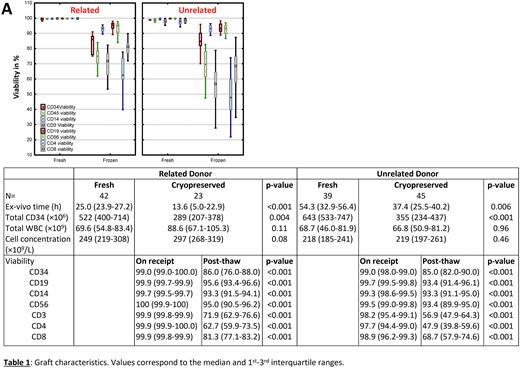Abstract
Background The active substance in a hematopoietic stem cell graft is considered the CD34+CD38- cell, which gives rise to long-term engraftment. The allograft contains a variety of immunologically active components such as granulocytes, monocytes and B-, T-, NK-cells, which make up more than 90% of total nucleated cells. FACT requires quality monitoring when a stem cell graft is substantially manipulated and its components altered. Cryopreservation is not considered a major manipulation and has been shown not to substantially influence the activity of CD34+CD38- cells. Most centers use fresh grafts but this changed substantially when COVID-19-related recommendations by transplant societies worldwide were imposed due to concerns regarding the risk of infection and interrupted supply chains. We raised the question as to whether graft travelling time, cell density of the graft and other factors might impact graft composition and viability before and after cryopreservation.
Results We prospectively analyzed 149 allogeneic peripheral blood stem cell grafts from the onset of COVD-19 pandemic restrictions in April 2020 for their composition upon receipt at our institution and after thawing following cryopreservation from April 2020 to March 2021. We examined the outcomes of the following graft types: related fresh n=42, related cryopreserved n=23, unrelated fresh n=39, unrelated cryopreserved n=45. Ex-vivo time was defined in hours from end of apheresis collection until cryopreservation or infusion of fresh product. Cell concentration was assessed in apheresis bag after collection. Viability was studied in the following populations and included 7-AAD exclusion assay: hematopoietic progenitors (CD34), monocytes (CD14), T-cells (CD3, CD4 and CD8), B-cells (CD19), NK-cells (CD56). Cryopreservation was undertaken by dump-freezing method. Grafts planned for cryopreservation were processed immediately, and fresh grafts were infused the next day.
The median ex-vivo time for related grafts was 23.9h (CI: 20.2-25.8) and for unrelated 39.3h (CI: 31.6-55.6). No graft exceeded 72h of ex-vivo time. Graft characteristics and pre- and post-cryopreservation viability are shown in Table 1. There was a significant drop in viable cells across all cell types with cryopreservation (Table 1, Figure A). Within the 72h range we found a negative correlation between ex-vivo time and fresh viability which was not significant for CD34 (r=-0.11, p=0.24) but significant for CD3 (r=-0.29, p=0.002), CD4 (r=-0.30, p=0.001) and CD8 (r=-0.28, p=0.003), the major graft component for control of malignant diseases. There was no correlation between cell concentration and cell viability for CD3 (r=0.05, p=0.61), CD4 (r=0.04, p=0.67) and CD8 (r=0.07, p=0.46). However, we found a correlation between cryopreservation and viability for all cell types (Figure A), most significantly for CD3 (r=-0.37, p=0.009), CD4 (r=-0.37, p=0.009) and CD8 (r=-0.38, p=0.007). We suspected an interaction between ex-vivo time, cell concentration and cryopreservation, and created a new variable (exvivotime × concentration) to account for this potential interaction. Analysis of the new integrated variable showed no significant correlation with neither fresh nor post-thaw viability of CD34 cells (fresh: r=-0.14, p=0.12, frozen: r=-0.15, p=0.14), but showed mild but significant impact on fresh CD3 viability (r=-0.25, p=0.006), CD4 (r=-0.27, p=0.004) and CD8 (r=-0.23, p=0.015), which was exacerbated by cryopreservation of CD3 (r=-0.57, p<0.001), CD4 (r=-0.55, p<0.001) and CD8 (r=-0.56, p<0.001). Correlations for monocytes (CD14), B-cells (CD19), NK-cells (CD56) were not significant.
Conclusion In summary, we show that graft constituents of PBSC apheresis are affected by travel time, and cryopreservation, by degrees that differ between cell types, with CD34 being most tolerant to these factors, and with T cells being the most affected. Furthermore, we show that the combination of long ex-vivo time and high cell concentration particularly impact T cell viability when grafts are cryopreserved. These data challenge general assumptions regarding what is considered the active ingredient in an allogeneic stem cell graft and how cryopreservation impacts on this ingredient. The data presented may have clinical implications for those patients receiving cryopreserved grafts with long ex-vivo times and higher cell concentrations.
Disclosures
No relevant conflicts of interest to declare.
Author notes
Asterisk with author names denotes non-ASH members.


This feature is available to Subscribers Only
Sign In or Create an Account Close Modal